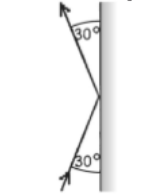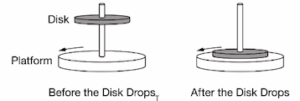0 attempts
0% avg
UBQ Credits
| Step | Derivation / Formula | Reasoning |
|---|---|---|
| 1 | \[p_{\text{before}} = m v_i \] | The clay’s initial momentum equals its mass times its speed. |
| 2 | \[p_{\text{after}} = (m+M) v_x \] | After sticking, the clay + bob move together with speed \(v_x\). |
| 3 | \[m v_i = (m+M) v_x \] | Linear momentum is conserved because the collision is perfectly inelastic and external horizontal forces are negligible. |
| 4 | \[v_x = \frac{m}{m+M} v_i \] | Solve algebraically for the common speed. |
| 5 | \[v_x = \frac{0.020}{0.020+0.500}\,(50) \;=\;1.92\;\text{m/s}\] | Insert \(m = 0.020\,\text{kg}\), \(M = 0.500\,\text{kg}\), and \(v_i = 50\,\text{m/s}\). |
| 6 | \[\boxed{v_x \approx 1.92\,\text{m/s}}\] | Speed of the combined mass just after impact. |
| Step | Derivation / Formula | Reasoning |
|---|---|---|
| 1 | \[\tfrac12 (m+M) v_x^2 = (m+M) g h \] | Kinetic energy right after collision changes into gravitational potential energy at the highest point. |
| 2 | \[h = \frac{v_x^2}{2g} \] | Cancel \((m+M)\) and solve for the height rise \(h\). |
| 3 | \[h = \frac{(1.92)^2}{2(9.81)} = 0.189\,\text{m}\] | Substitute \(v_x\) and \(g = 9.81\,\text{m/s}^2\). |
| 4 | \[h = L(1-\cos\theta)\] | The vertical rise of a pendulum bob is related to its length \(L\) and angular displacement \(\theta\). |
| 5 | \[\cos\theta = 1-\frac{h}{L} = 1-\frac{0.189}{0.800} = 0.764\] | Insert \(h\) and the string length \(L = 0.800\,\text{m}\). |
| 6 | \[\theta = \arccos(0.764) \approx 40.1^{\circ}\] | Take the inverse cosine to find the maximum angle. |
| 7 | \[\boxed{\theta_{\max} \approx 40.1^{\circ}}\] | Maximum angular displacement. |
| Step | Derivation / Formula | Reasoning |
|---|---|---|
| 1 | \[T = 2\pi \sqrt{\frac{L}{g}}\] | For small oscillations, the period of a simple pendulum depends only on its length and \(g\). |
| 2 | \[T = 2\pi \sqrt{\frac{0.800}{9.81}} = 1.79\,\text{s}\] | Insert \(L = 0.800\,\text{m}\) and \(g = 9.81\,\text{m/s}^2\). |
| 3 | \[\boxed{T \approx 1.79\,\text{s}}\] | Period of the clay-bob system. |
| Step | Derivation / Formula | Reasoning |
|---|---|---|
| 1 | \[E = \tfrac12 (m+M) v_x^2\] | Total mechanical energy is the kinetic energy right after the collision (identical to potential energy at the highest point). |
| 2 | \[E = \tfrac12 (0.520) (1.92)^2 = 0.961\,\text{J}\] | Use \(m+M = 0.520\,\text{kg}\) and \(v_x = 1.92\,\text{m/s}\). |
| 3 | \[\boxed{E \approx 0.961\,\text{J}}\] | Total energy of the oscillating system. |
Just ask: "Help me solve this problem."
A spring with spring constant \( k = 2.3 \) \( \text{N/m} \) is attached to an object of mass \( 10 \) \( \text{kg} \). If the object is hung from the ceiling by this spring, how much would the spring be stretched?
If a small motor does 520 J of work to move a toy car 260 meters in a time of 37 seconds.
A \( 1.0 \)\( \text{-kg} \) object is moving with a velocity of \( 6.0 \) \( \text{m/s} \) to the right. It collides and sticks to a \( 2.0 \)\( \text{-kg} \) object moving with a velocity of \( 3.0 \) \( \text{m/s} \) in the same direction. How much kinetic energy was lost in the collision?

A super dart of mass \(20 \, \text{g}\), traveling at \(350 \, \text{m/s}\), strikes a steel plate at an angle of \(30^\circ\) with the plane of the plate, as shown in the figure. It bounces off the plate at the same angle but at a speed of \(320 \, \text{m/s}\). What is the magnitude of the impulse that the plate gives to the bullet?

A platform is initially rotating on smooth ice with negligible friction, as shown above. A stationary disk is dropped directly onto the center of the platform. A short time later, the disk and platform rotate together at the same angular velocity, as shown at right in the figure. How does the angular momentum of only the platform change, if at all, after the disk drops? And what is the best justification.
\(1.92\,\text{m/s}\)
\(40.1^{\circ}\)
\(1.79\,\text{s}\)
\(0.961\,\text{J}\)
By continuing you (1) agree to our Terms of Use and Terms of Sale and (2) consent to sharing your IP and browser information used by this site’s security protocols as outlined in our Privacy Policy.
| Kinematics | Forces |
|---|---|
| \(\Delta x = v_i t + \frac{1}{2} at^2\) | \(F = ma\) |
| \(v = v_i + at\) | \(F_g = \frac{G m_1 m_2}{r^2}\) |
| \(v^2 = v_i^2 + 2a \Delta x\) | \(f = \mu N\) |
| \(\Delta x = \frac{v_i + v}{2} t\) | \(F_s =-kx\) |
| \(v^2 = v_f^2 \,-\, 2a \Delta x\) |
| Circular Motion | Energy |
|---|---|
| \(F_c = \frac{mv^2}{r}\) | \(KE = \frac{1}{2} mv^2\) |
| \(a_c = \frac{v^2}{r}\) | \(PE = mgh\) |
| \(T = 2\pi \sqrt{\frac{r}{g}}\) | \(KE_i + PE_i = KE_f + PE_f\) |
| \(W = Fd \cos\theta\) |
| Momentum | Torque and Rotations |
|---|---|
| \(p = mv\) | \(\tau = r \cdot F \cdot \sin(\theta)\) |
| \(J = \Delta p\) | \(I = \sum mr^2\) |
| \(p_i = p_f\) | \(L = I \cdot \omega\) |
| Simple Harmonic Motion | Fluids |
|---|---|
| \(F = -kx\) | \(P = \frac{F}{A}\) |
| \(T = 2\pi \sqrt{\frac{l}{g}}\) | \(P_{\text{total}} = P_{\text{atm}} + \rho gh\) |
| \(T = 2\pi \sqrt{\frac{m}{k}}\) | \(Q = Av\) |
| \(x(t) = A \cos(\omega t + \phi)\) | \(F_b = \rho V g\) |
| \(a = -\omega^2 x\) | \(A_1v_1 = A_2v_2\) |
| Constant | Description |
|---|---|
| [katex]g[/katex] | Acceleration due to gravity, typically [katex]9.8 , \text{m/s}^2[/katex] on Earth’s surface |
| [katex]G[/katex] | Universal Gravitational Constant, [katex]6.674 \times 10^{-11} , \text{N} \cdot \text{m}^2/\text{kg}^2[/katex] |
| [katex]\mu_k[/katex] and [katex]\mu_s[/katex] | Coefficients of kinetic ([katex]\mu_k[/katex]) and static ([katex]\mu_s[/katex]) friction, dimensionless. Static friction ([katex]\mu_s[/katex]) is usually greater than kinetic friction ([katex]\mu_k[/katex]) as it resists the start of motion. |
| [katex]k[/katex] | Spring constant, in [katex]\text{N/m}[/katex] |
| [katex] M_E = 5.972 \times 10^{24} , \text{kg} [/katex] | Mass of the Earth |
| [katex] M_M = 7.348 \times 10^{22} , \text{kg} [/katex] | Mass of the Moon |
| [katex] M_M = 1.989 \times 10^{30} , \text{kg} [/katex] | Mass of the Sun |
| Variable | SI Unit |
|---|---|
| [katex]s[/katex] (Displacement) | [katex]\text{meters (m)}[/katex] |
| [katex]v[/katex] (Velocity) | [katex]\text{meters per second (m/s)}[/katex] |
| [katex]a[/katex] (Acceleration) | [katex]\text{meters per second squared (m/s}^2\text{)}[/katex] |
| [katex]t[/katex] (Time) | [katex]\text{seconds (s)}[/katex] |
| [katex]m[/katex] (Mass) | [katex]\text{kilograms (kg)}[/katex] |
| Variable | Derived SI Unit |
|---|---|
| [katex]F[/katex] (Force) | [katex]\text{newtons (N)}[/katex] |
| [katex]E[/katex], [katex]PE[/katex], [katex]KE[/katex] (Energy, Potential Energy, Kinetic Energy) | [katex]\text{joules (J)}[/katex] |
| [katex]P[/katex] (Power) | [katex]\text{watts (W)}[/katex] |
| [katex]p[/katex] (Momentum) | [katex]\text{kilogram meters per second (kgm/s)}[/katex] |
| [katex]\omega[/katex] (Angular Velocity) | [katex]\text{radians per second (rad/s)}[/katex] |
| [katex]\tau[/katex] (Torque) | [katex]\text{newton meters (Nm)}[/katex] |
| [katex]I[/katex] (Moment of Inertia) | [katex]\text{kilogram meter squared (kgm}^2\text{)}[/katex] |
| [katex]f[/katex] (Frequency) | [katex]\text{hertz (Hz)}[/katex] |
General Metric Conversion Chart
Example of using unit analysis: Convert 5 kilometers to millimeters.
Start with the given measurement: [katex]\text{5 km}[/katex]
Use the conversion factors for kilometers to meters and meters to millimeters: [katex]\text{5 km} \times \frac{10^3 \, \text{m}}{1 \, \text{km}} \times \frac{10^3 \, \text{mm}}{1 \, \text{m}}[/katex]
Perform the multiplication: [katex]\text{5 km} \times \frac{10^3 \, \text{m}}{1 \, \text{km}} \times \frac{10^3 \, \text{mm}}{1 \, \text{m}} = 5 \times 10^3 \times 10^3 \, \text{mm}[/katex]
Simplify to get the final answer: [katex]\boxed{5 \times 10^6 \, \text{mm}}[/katex]
Prefix | Symbol | Power of Ten | Equivalent |
|---|---|---|---|
Pico- | p | [katex]10^{-12}[/katex] | 0.000000000001 |
Nano- | n | [katex]10^{-9}[/katex] | 0.000000001 |
Micro- | µ | [katex]10^{-6}[/katex] | 0.000001 |
Milli- | m | [katex]10^{-3}[/katex] | 0.001 |
Centi- | c | [katex]10^{-2}[/katex] | 0.01 |
Deci- | d | [katex]10^{-1}[/katex] | 0.1 |
(Base unit) | – | [katex]10^{0}[/katex] | 1 |
Deca- or Deka- | da | [katex]10^{1}[/katex] | 10 |
Hecto- | h | [katex]10^{2}[/katex] | 100 |
Kilo- | k | [katex]10^{3}[/katex] | 1,000 |
Mega- | M | [katex]10^{6}[/katex] | 1,000,000 |
Giga- | G | [katex]10^{9}[/katex] | 1,000,000,000 |
Tera- | T | [katex]10^{12}[/katex] | 1,000,000,000,000 |
The most advanced version of Phy. 50% off, for early supporters. Prices increase soon.
per month
Billed Monthly. Cancel Anytime.
Trial –> Phy Pro
We crafted THE Ultimate A.P Physics 1 course so you can learn faster and score higher.
Try our free calculator to see what you need to get a 5 on the upcoming AP Physics 1 exam.
A quick explanation
Credits are used to grade your FRQs and GQs. Pro users get unlimited credits.
Submitting counts as 1 attempt.
Viewing answers or explanations count as a failed attempts.
Phy gives partial credit if needed
MCQs and GQs are are 1 point each. FRQs will state points for each part.
Phy customizes problem explanations based on what you struggle with. Just hit the explanation button to see.
Understand you mistakes quicker.

Phy automatically provides feedback so you can improve your responses.
10 Free Credits To Get You Started

By continuing you agree to nerd-notes.com Terms of Service, Privacy Policy, and our usage of user data.
NEW! PHY AI accurately solves all questions
🔥 Get up to 30% off Elite Physics Tutoring
🧠 NEW! Learn Physics From Scratch Self Paced Course
🎯 Need exam style practice questions?